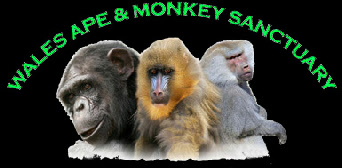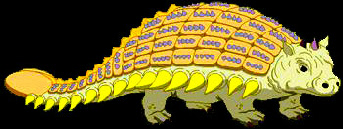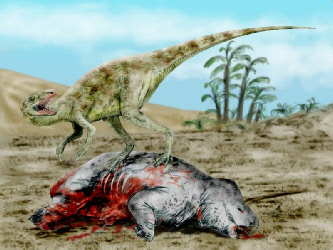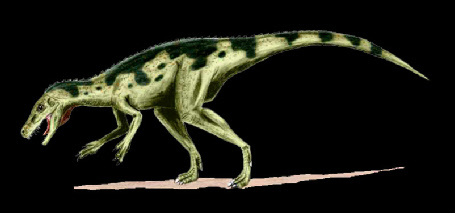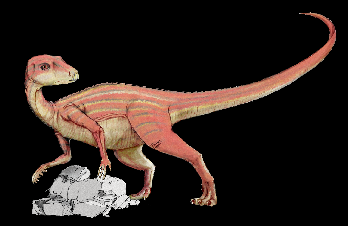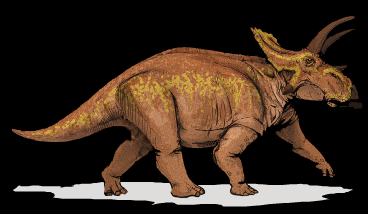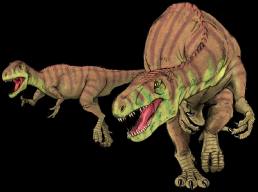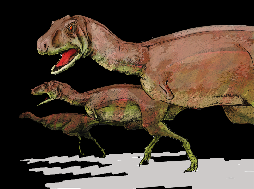
The Later Eras (Mesozoic and Cainozoic)
Comprising the Triassic, Jurassic,Cretaceous & Tertiary Periods
As the 370 million year Palaeozoic Era came to an end with great geological activity and the mass extinctions of up to 95% of the marine species which it had produced, the World moved into the Mesozoic era which started with the Triassic period.
The Triassic Period 248 to 210 million years ago
Land based species such as plants and reptiles had fared much better than their aquatic relatives who had been decimated by the great Permian extinctions, and they continued to evolve and colonise large areas of the dry land. At this time the continents as we know them today were still bunched together as one super continent, spanning the equator and the tropics. This allowed migrations of animals across vast distances and with the appearance of the Dinosaurs which were initially small (3 to 5 metres long), but quick, these creatures soon began to dominate.
The first Dinosaurs were still Lizard-like with short legs and bodies close to the ground, some did learn to stand upright however. Although more active and versatile than the lizards and other reptiles of the time they themselves were mostly forced into extinction by larger and superior species by the end of the Triassic Period.
True Conifers developed in the drier uplands and Cycads with crowns of palm-like leaves flourished as climates continued to remain tropical across much of the land mass which we now call Europe.
The Jurassic Period, 195 to 136 million years ago
This was the age of the massive dinosaurs which have commanded so much interest in films, television and children's books. They ranged widely, but fossils are only found in sedimentary rocks, and the rocks of the Abercrave ( Abercraf ) area had already formed by this time. Only in a few parts of the World were good fossil records of these large creatures laid down. Dinosaurs were certainly active in Europe and Britain however and many species would have lived in Wales .
The Afrovenator Abakensis on the left is typical of the large carnivorous Dinosaurs of the Jurassic period whilst Segosaurus was a small scavenger, only around 1 metre long when fully grown. The largest Dinosaurs were the herbivores however such as Diplodocus which could reach 85ft in length. With a low body but long neck and tail they could feed on the highest growing vegetation.
Plant life flourished and continued to evolve in the warm sub-tropical climate with huge conifers, ferns and the first flowering plants appearing. The constant evolution of plants caused a continuous "background" extinction of the Dinosaur species that specialised and depended on specific plants, which were being superseded by new varieties. Carnivorous Dinosaurs dependant on their vegetarian cousins for a supply of meat starved and died with them.
The Cretaceous Period 136 to 71 million years ago.
This was the last chapter in the age of the Dinosaurs who through quite rapid evolution had literally conquered every niche offered by their terrestrial world. The cost of this rapid evolution however was the constant "background" extinction of species, and a trend towards increasing body weights, which required large volumes of food. As a result they became less able to survive the changes in their environment and, even before their sudden and complete disappearance from the fossil records of 66 to 64 million years ago, many species had already become extinct.
There are various theories as to what caused the sudden extinction of the larger Dinosaurs, and still some controversy as to whether birds are the descendants of the smaller species. At the end of the Cretaceous the first mammals began to appear. These were initially small creatures such as rodents, but their descendants developed into the animals we have today. Animals have replaced the dinosaurs as dominant species at the top of the food chain in many environmental niches.
The Tertiary Period 65 to 1.64 million years ago
Generally split into two sub-periods, the Early Tertiary (Palaeogene) and Late Tertiary (Neogene), By the early Tertiary Period most non avian dinosaurs were extinct. This was the age of the mammals. This long span of time is divided into five epochs, the Palaeocene, Eocene, Oligocene, Miocene and Pliocene. The continents took on their present forms and the climate deteriorated from the wet tropical Miocene epoch through to cooler and drier Miocene and Pliocene epochs. Many modern types of flowering plants, insects, fish, molluscs, amphibians, reptiles and birds evolved and apart from some mammalian and reptilian forms, which developed later in the present Quaternary period (the Pleistocene epoch). Most of today's species were present by the late Tertiary Period but few fossils remain of early Triassic mammals as they were only small animals and rodents whose bones decomposed before fossilisation was complete.
